Since the introduction of Hydropathy into Matlock
by the late
Mr John Smedley, it has developed as
rapidly as any of the acquired sciences; but at no
place has the water cure system gone through more
varied changes than at the "Home" of this beneficial
treatment.
Smedley's Hydro about 1915
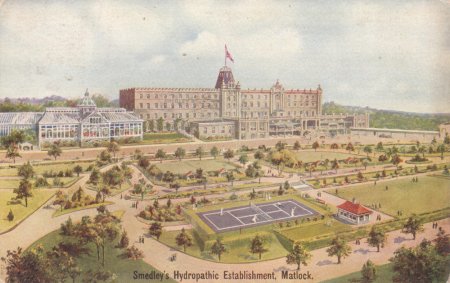
|
From the humble cottage situate on
Matlock Bank, where the genius of John Smedley
laid the nucleus of the famous institution which has
his name for its powerful attraction, and his principles
of comfort and convenience for its aim, no
greater transformation has taken place amongst the
hundreds of establishments which have originated
from his ideas than at the sanatorium which carries
on the universal hygienic business under his world-known
title.
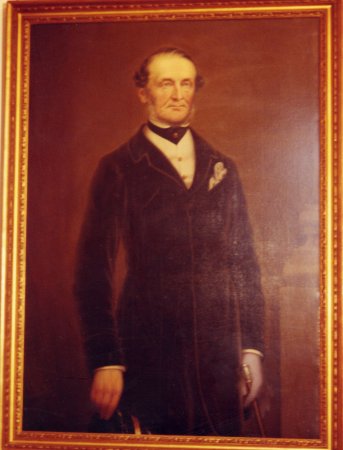
|
John & Caroline Smedley, 1867
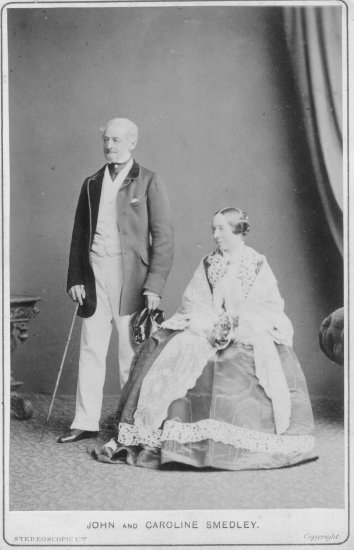
|
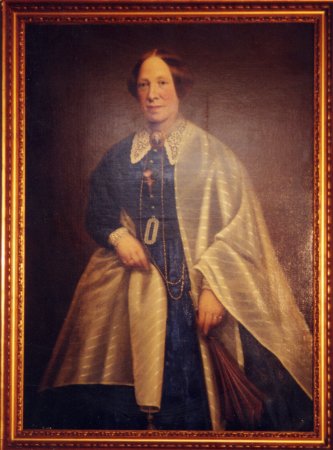
|
Smedley's at Matlock Bank has
"mended its ways" indeed. Within its walls is
sufficient splendour to make the most fastidious lead
happy lives. Colonel Burnaby, in his "Ride to
Khiva", relates that he saw over a Russian tavern
door the enticing invitation "get drunk and be
happy, all for a penny". At Smedley's you have
a distinct advantage over this; you can, and
must, keep sober, and be thoroughly merry -
well, not gratis, but for a moderate sum. The
doors are open as freely to the artisan as the
millionaire. It has sheltered foreign potentates,
distinguished noblemen in diplomacy and statecraft,
and the noblest and grandest have honoured it with
their presence. The visitors' book is a gazetteer
which includes patients from Australia, China, India,
America, and all parts of Europe. The history of
Hydropathy is not yet penned. When it is the
potent name which formed the most interesting
annal of this system of physiological treatment will
be inscribed in the contents. John Smedley is
incomparably associated with hydropathy, and to his
experiences and experiments some parts of Derbyshire
owe very much of its prosperity, and thousands will
concede they have been relieved from suffering. It
is said that water was the sole article in the pharmacopoeia
of Napoleon I. The great Corsican is reputed to
have thus addressed an Italian physician: "Believe
me, we had better leave off all those remedies.
Life is a fortress which neither you nor I know anything
about. Why throw obstacles in the way of its
defences? Its own means are superior to all the
apparatus of your laboratories." Napoleon, then,
believed in water when he referred to nature's means
as superior to physic.
Hydropathy is growing in favour in all parts of
England. Ample evidence of this association is found
in the new hydros which are opened on every side.
The medical faculty do not, as a rule, hold it to be a
slow and certain slayer, as they did years ago. Dr.
F.Armstrong, in the Medical Commentaries, years
ago, wrote: "I have taken great pain to examine
particularly into the properties of the Matlock
springs, and may with truth assert that they are of
the same nature with the Bristol water, equal in
some cases and preferable in many." Again he
adds: "I have, in the course of seven years, sent
a great number of patients to Matlock, and in cases
where medicine had not the least prospect of being
serviceable: all of whom have had perfect and
lasting cures; and may with truth declare I have
not failed in one instance." He afterwards observes:
"I perfectly agree with Dr. Percival, that a larger
quantity of Matlock water may be drunk at a time
than any other mineral water I am acquainted with,
owing to the entire absence of any mineral spirit;
yet it is always advisable to begin with small
quantities. From the want of mineral spirit it
is less apt to throw the circulation of the
blood into irregularities, or quicken the pulse;
and therefore it must have the preference. to Bristol
water in phthisis, pulmonalis, haemoptor, diabetes,
fluor albus &c. In all those I have experienced the
most happy effects from it, as well as in hysteric and
hypochondriac affections, profluvium, or deficiency of
catemenia, in bilious disorders, in constitutions
debilitated by long and severe vernal and autumnal
intermittents, in disorders arising from long residence
in hot climates, in broken constitutions brought on
by hard and habitual drinking, and in weak and
depraved appetites." There are numerous other
treatises which deal with Matlock water as a corrective
for many ailments.
It is not merely in the warm months that Matlock
is in request to invalids and those who are
disappointed of the advantages of a more genial climate
in the Sunny South. In winter it is equally favourable.
The place is effectually sheltered from cold
winds by the nature of its situation.
The growth of Smedley's institution is without
rival. The late philanthropist commenced in an
ordinary cottage. He had no medical education, but
had long studied human physiology. The more
he pondered over this subject the more convinced
he became of the inexpediency of
bleeding, cupping, and the other drastic remedies
these employed. He commenced in a house fitted to
accommodate six persons. The numbers gradually
increased to about 1,600 per annum, and in 1867
they had reached 2,000. At this number the patients
remained for some years, owing to want of
accommodation. In 1867 so many persons were refused
admission that Mr Smedley decided upon the erection
of a new and commodious building. It was
completed a year later, the engineer, architect and
clerk of the works being Mr Smedley himself.
The Hydro in 1869
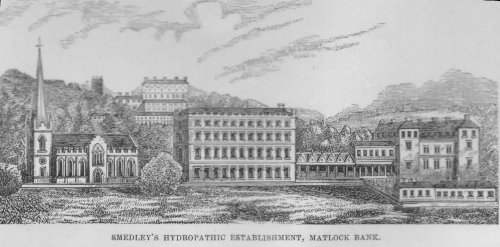
|
Then the patients rose to 2,500 per annum. During this
time the whole responsibility was upon Mr Smedley.
His patients were scattered all over the world, and
with them he had correspondence. Besides, he
advised upon every case, and was at business by five
o'clock every morning. The strain was too heavy,
and he became anxious to secure the services of a
medical gentleman to relieve him of the personal
supervision of cases. It was not until 1872 that Dr.
W.B.Hunter was met with. To him was given the
sole charge of the medical department. The choice
was judiciously made, and the name of Dr.
Hunter is as popular as any specialist of the day.
To him Smedley's is largely indebted for its present
renown. In 1875 the institution as acquired by
a limited company, with a capital of £50,000.
Probably over 3,000 cases are dealt with annually,
and with the increased accommodation these numbers
will be exceeded in future.
The establishment is fitted with all the modern
appliances for bathing, cooking, and every comfort
which human foresight can discover. There are
extensive pleasure gardens, tennis lawns, skating
rinks &c, &c. When the premises came into the
possession of the present company steps were at once
taken to improve and enlarge them.
Plan of Smedley's dated 1875
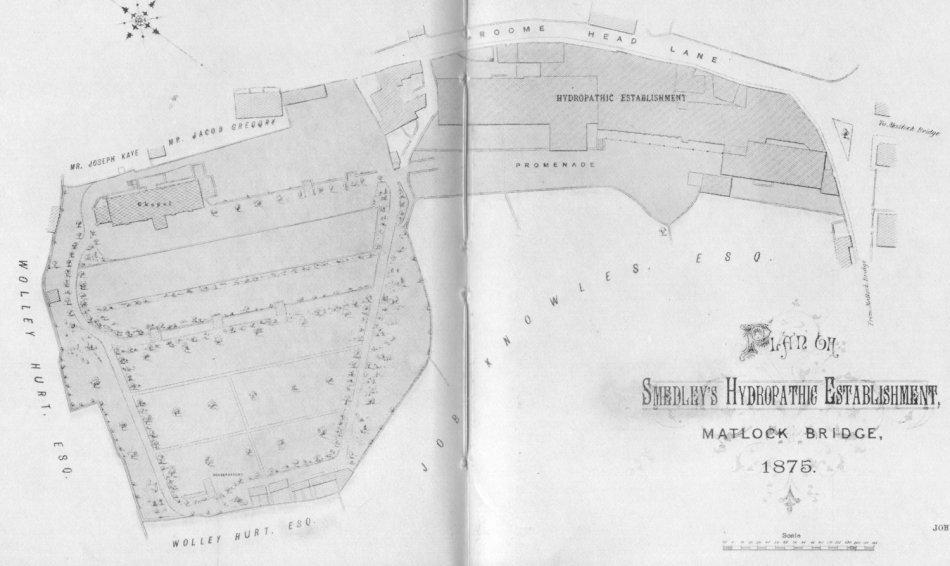
|
It was decided
to do the work in four sections. The first was
commenced in January 1881, and included a
spacious entrance hall, grand staircase, bedrooms,
reception rooms, lavatories, secretary's office, and
other rooms. The entire cost was placed at £30,000,
and the style adopted that of the Queen Anne period.
The whole of the woodwork is American walnut,
interspersed with oak. An elaborate dado of walnut
runs around the walls, the upper parts being effectively
covered with lincrusta walton. At the south end of
the hall is a memorial window to the late Mr.
Smedley. It was erected by public subscription,
and contains over 300 square feet of glass,
the cost being about £350. The symbolical
figures are: In the centre, Truth seated in a well
holding her symbols, a glass of water and a mirror;
to the left a figure of Hygeia, and to the right one of
Aesculapius. The second section was begun in 1884,
and comprises dining-hall, bedrooms, and a lofty
corridor, 100 feet in length, connecting the east and
west "wings". The dining-hall is most ornately
designed, and is 90 ft by 45 ft, the roof resting upon
twenty eight Corinthian pillars. It has accommodation
for 350 guests. This section cost £10,000,
making an immense improvement. The third section
was commenced in October of 1886. It consisted
of the main front of the building, looking
over the valley in the direction of Masson and
Matlock Bath. The facade is designed in Italian
renaissance style, very freely treated. The effect is
very imposing and elegant, both internally and
externally. The new drawing room is 95 ft long,
45 ft wide and 22 ft high. The roof is constructed
of iron concrete, and forms a promenade. Besides
twenty-eight bedrooms are added in this block,
recreation room, 80 ft by 30 ft; private dining room,
27 ft by 18 ft; ladies' and gentlemen's cloak and
ante rooms; matron's and manager's offices. It is
more particularly with this new portion we have to deal.
As we have stated, in October 1886, a contract was
let to
Mr L.J.Wildgoose, of Matlock, for the
construction of the third block of buildings. The plans
were prepared by
Mr G.E.Statham, architect, of
Nottingham and Matlock, as were all the other
designs for the company. The actual figures for the
masonry were £5107, and, of course the extras
increased the sum. The woodwork was undertaken by
Messrs. Moore Brothers of Rawtenstall at a cost of
£2924, and the furnishing and decorating was placed
in the hands of Messrs. Foster and Cooper, of Nottingham.
Of the capabilities of these firms nothing
need be said. They have executed the work in the
most finished style, and Smedleys will serve as a
reference for them, which, for general excellence,
cannot be excelled. To give a description of the
new drawing room is a task of no ordinary
character. It is superb and perfect. The opinion
obtains that the room is second to none in any
semi-private place in the country. At one end is
a permanent stage, 20 ft deep and 20 ft wide,
with ante-rooms.
Grand Drawing Room looking North West
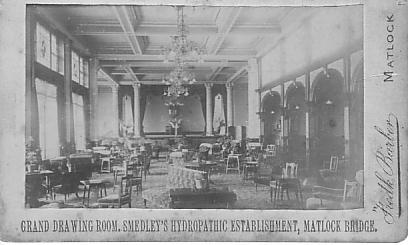
|
It is flanked by Corinthian
columns and pilasters. The stage is as large as
those in most of the leading theatres. All the
architectural work is of free classic style, from the
plans of Mr Statham. This magnificent room is
elaborately decorated and furnished in artistic taste.
There are six recesses on one side. These are
arranged to give a sight of the great hills to the west
and south. The seats are upholstered in electric blue
frieze velvet, tastefully draped with velvet curtains.
The woodwork is richly carved, and the seats are
fixed for a view of almost the entire room. In one
of these recesses is a beautifully carved mantelpiece
of exquisite design. opposite the recesses are six
spacious windows, with fanlights above. The windows
are of costly stained glass, the centre panels of
which are figures representing the Muses. One of
the features of this elegant apartment is the
embroidered blinds, which give an artistic
effect and splendour to the rest of the
room. The window curtains are also of the
richest velvet. The woodwork is chastely decorated.
The doors, the recesses, and the windows are
done in solid walnut, all finely carved. The dado is
of Japanese paper, whilst the middle part is an ordinary
rich blue paper, with a handsome fringe running
round the top. The floor is covered with a carpet
which has been specially manufactured for Messrs.
Foster and Cooper, in Bohemia. It is about one ton
in weight, and is made entirely by hand, by skilled
people, and can scarcely be said to wear out. The
splendid thickness and softness of the pile makes it
like walking upon moss. It is luxurious and costly,
and fits exactly in every part, like one immense piece,
though on account of the great weight it was necessary
to have several sections. The settles, ottomans,
and chairs have been specially designed and constructed
so as to take apart and form in line for
entertainments.
Grand Drawing Room looking South East,
taken about 1910.
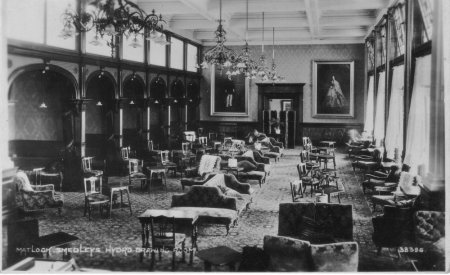
|
The colours are various, principally
the electric blue and old gold. There are centre
tables, card tables, all made en suite. The roof is
most delicately and prettily decorated with cream
and gold, interspersed with terra cotta and light blue.
To say the room is immensely rich does not convey
an idea of the exceeding beauty contained within the
four walls. Messrs. Foster and Cooper have more
than pleased the directors and the architect with
their workmanship. Along with the furnishing of
20 bedrooms Mr C.E. Hughes took the contract on
their behalf for the whole of the important work.
There is another important innovation to be
noticed at Smedley's. Messrs. J.H.Holmes and Co.,
of Newcastle, have laid apparatus for electric lighting
throughout the place. The system is the Swan
incandescent. There will be 350 lights, but the
directors have wisely not dispensed with gas. In
the event of any mishap the gas can be used as
previously.
Mr W.B. Askew, of Matlock, is erecting
an engine house near the laundries, on the road side
opposite the central block. The cost is estimated at
about £1,500. When the corridors, offices, and rooms
are illuminated with electricity the effect will be
charming. At present the engine is not fixed, but
the whole of the other appliances are ready.
The company's architect
Mr G.E.Statham, may
be warmly congratulated on his admirable schemes
and the methodical manner in which they have been
carried into effect. The comfort of visitors has
scarcely been interfered with, and this is a consideration
when not less than 100 patients are staying
there at once.
Mr W.Doxey has been the clerk
of the works from the first commencement. He has
spent the last 30 years, with the exception of short
intervals, in the service of Mr Smedley and the
present proprietors. Under his direction the premises
were heated with steam.
We cannot omit to mention the arduous duties of
Mr A.H. Douglas, the manager, who holds a very
responsible position. He is courteous and obliging,
and has the interests of the gigantic concern in his
care. Along with the matron, he has to regulate the
establishment and the large staff of over 150
servants.
The ceremony of formally opening the new
drawing room took place last Friday [22 June 1888]. At
two o'clock a recherche dinner was provided, and 190
guests sat down. Amongst those present were:
Mr R.Wildgoose J.P.(one of the directors), and
Mrs Wildgoose,
Rev J.W.Kewley (rector of Matlock),
Rev.V.Ward and
Mrs Ward,
Rev.E.Clark (chaplain),
Dr Hunter,
Dr Corkhill
&c, &c. The following
was the
MENU
SOUPS
Clear turtle Bisque de Homard
FISH
Boiled salmon - sauce Mousseline
Fried sole - sauce Tartare
ENTREES
Volaille de Bresse a la Bohemienne
Canard aux petits pois nouveaux
JOINTS
Roast beef Roast mutton
VEGETABLES
Asparagus Spinach New potatoes
SWEETS
Gooseberry tart Pouding a Porange
Tapioca Custards
Gelec a la Russe
Creme au Moka Patisserie
STEWED FRUITS
Green figs Peaches
DESSERT
Pines Apples Oranges Apricots &c
Subsequently the company adjourned to the
drawing room, when a grand concert was given.
The performers comprised the principal soloists
from the Buxton Pavilion Band, with Herr Hermann
Kiel as leader, and Mr Evelyn Timmins, Matlock
Bath, as conductor. Mr J.G. Barker, A.C.O.
accompanied the songs with taste and skill. Miss
Edith Bryan, Matlock Bath, was announced to sing
"Our Last Waltz", but through indisposition she
was unable to attend. A lady visitor took her place,
and sang "My Daring Heart" with pleasing effect.
Mr Charles Conriney gave "Gallants of England"
in a powerful, rich voice. The programme, which
was arranged with excellent taste, included the
overture "Zampa"; valse "Les Patineurs"; intermezzo
"Forget-me-not"; selection "Mikado";
cornet solo "Lost Chord"; xylophone solo (encored);
and the march "Gamorra". The concert was enjoyed
most thoroughly, and its only fault was that of being
terminated too soon. At considerable cost the
directors had engaged the band, which gave every
possible satisfaction.
In the evening a grand ball was given in the
dining hall, Mr J.H. Barnes' orchestral band being
entrusted with the important engagement. The
music they supplied was of the newest description,
and gave complete satisfaction to the large and
fashionable company which assembled. The programme
was as follows: Valse "Les Sourires";
quadrille "Welcome Friends"; polka "Tres Gai";
valse "Mirage"; lancers "Ruddigore"; schottische
"Dorothy"; valse "Love's Dreamland";
quadrille "Merry songs"; valse "Saionara";
valse "The Old Guard"; polka "En Foret";
lancers "Jolly Life"; valse "Soiree D'Ete"; valse
"Sympathy".
The success of Smedley's seems phenomenal, as
year by year the visitors increase with the comforts
of the colossal structure. There is yet another
section to build, but this may be some time before it is
put in hand. The buildings alone cover one and a
half acres. It need not be added the treatment here
obtained is of the most perfect description, the diet
varied and judicious, and nothing remains to enhance
the charms of the establishment.
Transcribed from The High Peak News 23 Jun 1888
Article entitled Smedley's at Matlock and Opening the new Drawing Room
|








 .
All Rights Reserved.
.
All Rights Reserved.